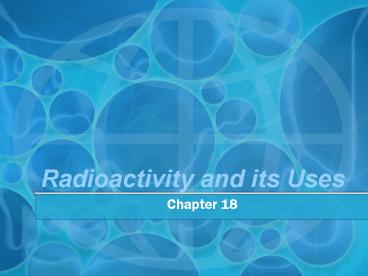Radioactivity and its Uses - PowerPoint PPT Presentation
1 / 14
Title:
Radioactivity and its Uses
Description:
Radioactivity and its Uses Chapter 18 Standards: PS 2.6: Compare fission and fusion (including that basic processes and the fact that both fission and fusion convert ... – PowerPoint PPT presentation
Number of Views:714
Avg rating:3.0/5.0
Title: Radioactivity and its Uses
1
Radioactivity and its Uses
- Chapter 18
2
Standards
- PS 2.6 Compare fission and fusion (including
that basic processes and the fact that both
fission and fusion convert a fraction of the mass
of interacting particles into energy and release
a great deal of energy). - PS 2.7 Explain the consequences that the use of
nuclear applications (including medical
technologies, nuclear power plants, and nuclear
weapons) can have.
3
What Causes Radioactivity?
- Nucleus made of protons and neutrons
- protons and neutrons held together in tightly
packed nucleus by the strong force
strong force acts over very small distances only!
4
What is Radioactivity?
- Nuclear decay which happens when the strong force
is not large enough to hold the nucleus together
nucleus gives off matter and energy - A nucleus with too many or too few neutrons
compared to protons is radioactive - Question?
- Why are large nuclei more likely to be
radioactive than small nuclei?
5
Radioactivity and Nuclear Reactions
6
Fission
- when a neutron is fired into a nucleus, the
nucleus splits and a lot of energy is released
(Emc2) - only happens with large nuclei such as uranium
and polonium - to divide
- LOTS of energy given off
- Used in nuclear
- reactors/power plants
- to turn water into steam
- which turns a turbine to
- generate electricity
10n 23592U ? 9136Kr 14256Ba 310n
energy
7
Chain Reactions
- 3 neutrons released by first reaction can cause
fission in three more nuclei - process grows exponentially
- 3 ? 9 ? 27 ? 81 ? 243 ? 729
- this is called a chain reaction an ongoing
series of fission reactions - - in power plants and nuclear reactors control
rods, neutron absorbers, are used to slow down
the chain reaction
8
Critical Mass ?
- In order for a chain reaction to occur, there
must be a certain minimum amount of - critical mass - the amount of fissionable
material in close proximity for a chain reaction
to occur. - The mass of the products of a fission reaction
are less than the mass of the reactants - This lost mass is converted into energy.
- The conversion of mass to energy during a nuclear
reaction involves more energy than the amount of
energy involved in a chemical reaction
9
Fusion
- the combining of two small nuclei
- requires very high temperatures (1 million ?C)
process that occurs in stars
11H 21H ? 32He energy
10
Radioactivity in Medicine
- Tracer radioactive isotope used to follow how a
molecule travels through your body or through any
process scientists wish to monitor - red flag on a molecule
- Benefits can target certain cells, such as
cancer cells - We tag them with radioactive samples of the same
substance in questionthe radioactivity can be
traced by Geiger counter or gamma cameras - Possible drawbacks Waste
- must be stored until it is no
- longer radioactive
- Also kills healthy cells
11
- examples
- iodine 131 (emits beta particles and gamma
rays) - used to detect thyroid problems - fluorine 18 used in PET scans to detect brain
problems - gold 198, iridium 192 injected into
cancerous cells to kill the cells - cobalt 60 gamma rays from isotope used to
kill cancerous cells from outside the body
12
Other uses ?
- Nuclear Weapons-
- Benefits
- Some people think they deter war
- Drawbacks
- Smuggling of material possible
- Tremendous amounts of destruction
- Contamination of environment
- Wastecould leak radioactive isotopes and be
harmful long-term
13
- Nuclear Reactors-
- Benefits
- Tremendous amounts of energy from little material
- No greenhouse gases
- Can be used anywhereuses no fossil fuels
- Drawbacks
- Pollute water systems
- Requires specialized technology
- Waste
- Exposure to workers
- Accidents of poorly maintained facilities (ex
Chernobyl)
14
Nuclear power plant

